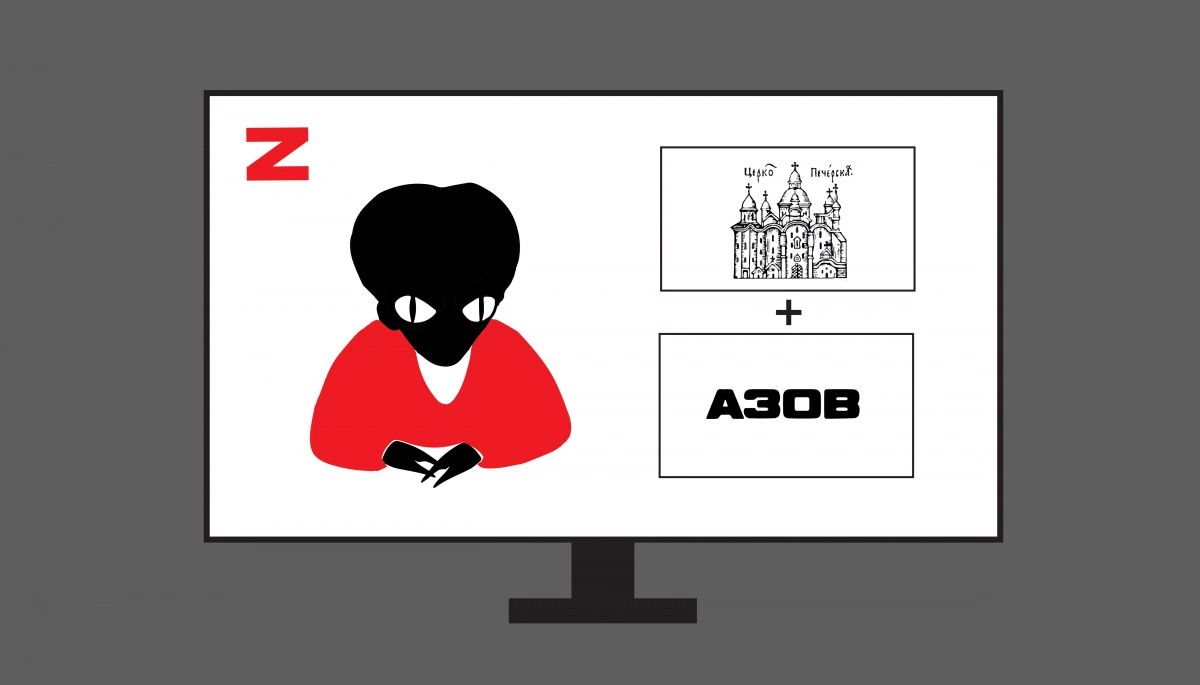Українською читайте тут.
Since February 24, 2022, Detector Media has been
monitoring the Ukrainian segment of social networks as well as the Kremlin
media and documenting the chronicle of Russian
disinformation about Russia’s war against Ukraine on a daily basis. Over time,
we started making regular reviews. Read the latest ones here: June 5-11, June 12-18, June 19-25, June 26-July 2, July 3-9, July 10-16, July 17-23, July 24-30, July 31-August 5, August
7-12, and the summary for ten months, as
well as a review of the most
ridiculous fakes produced during the year of the full-scale war.
From August 14 to 19, 2023, around 30 instances of disinformation were identified by analysts at Detector Media. In this period, propagandists purported that the West had “forsaken” Ukraine and failed to deliver the security assurances given at the Vilnius summit. They also alleged that Kyiv was trading American weapons to Mexico and that Zelenskyy was warning Duda of a potential recurrence of the Volyn tragedy, as depicted on a German weekly’s cover. Find out the details in our article.
“Azov Members Occupying the Lavra”
Certain Russian media channels echoing pro-Kremlin rhetoric have published a fake that the Kyiv Pechersk Lavra will be taken over by soldiers from Azov, who will “yell, use profanities, indulge in newly legalized substances, consume alcohol, ridicule, and engage in unruly behavior.” In contrast, the Kyiv-Pechersk Lavra National Reserve has introduced a “Spiritual Recovery through Culture” initiative for the military. Over a week, military personnel and chaplains will engage with clergy, historians, art experts, archaeologists, and more. As part of this, chaplains will reside in the National Academy of Culture and Arts Leadership’s quarters. Hence, there is no indication of military personnel settling there indefinitely or of transferring the Lavra to the Ukrainian Armed Forces.
The spotlight on activities around the Lavra has not waned over the past year. In November 2022, searches were carried out by the Security Service of Ukraine at multiple religious sites, including the Kyiv Cave Monastery. They found substantial cash amounts, Russian nationals possessing questionable documents, and literature discussing the “tsar” and the “one people.” On January 5, 2023, control of certain sections of the Kyiv-Pechersk Lavra was regained by the state. By March 30, 2023, Ukraine’s Cabinet of Ministers revoked the 2013 order that had leased the Kyiv-Pechersk Lavra’s property to the Ukrainian Orthodox Church of the Moscow Patriarchate free of charge. The property was subsequently placed under state management. The monks have been hesitant to vacate the Lavra’s grounds. Meanwhile, propagandists have been looking for every opportunity to tarnish the relocation process, amplifying its controversy. The Ukrainian Orthodox Church of the Moscow Patriarchate (UOC-MP) frequently portrays the events at the Lavra as violent “evictions and attacks,” while law enforcers describe it as maintaining civil order. By sensationalizing the Lavra incidents, propagandists aim to garner more support and rally “worried followers.” They paint a grim picture of Azov soldiers intending to defile sacred grounds, playing on UOC-MP believers’ emotions and making them feel persecuted. This narrative not only fosters animosity towards the Azov soldiers, seen as violators of sanctity but also towards the authorities that supposedly allow this to happen.
“Western Nations Deny Security Assurances to Ukraine”
Russian media outlets have been disseminating the misleading narrative that the West has turned its back on Ukraine regarding security assurances. They cite lawyer Mykhailo Soldatenko, suggesting he made such claims in a piece for Ukrainska Pravda. This representation is inaccurate. Soldatenko did not state that the G7 countries were rejecting security assurances to Ukraine. Rather, he highlighted the absence of the term “guarantees” in the G7 leaders’ declaration after the NATO Summit in Vilnius in July 2023. At present, Ukraine is in discussions with the United States and the United Kingdom about a potential bilateral security assurance agreement.
At the aforementioned NATO Summit, the G7 nations agreed on a framework document detailing “security guarantees” for Ukraine. While specifics were not ironed out, the foundation was laid. Notably, the term “guarantees” was absent because true legal security guarantees don’t exist globally. For instance, even the NATO treaty doesn’t explicitly oblige members to deploy military forces for each other’s defense. Instead, there is only a clause on assistance. Therefore, as part of the agreements with Western partners, Ukraine will not receive what can be called full-fledged “security guarantees,” and this term will not be in the documents because our partners will provide us with legally binding guarantees of support in the war. The purpose of the bilateral documents, no matter what we call them, is to ensure the stability of arms supplies even during the period of change of government in the guarantor states. With such manipulative statements, the Russian propaganda machine is trying to devalue the assistance of Western partners to impose the idea that their support for Ukraine is gradually declining and that we will soon be left all alone.
“Ukraine Channels US Weapons to Mexican Cartels to Fight the Americans”
Russian media outlets that broadcast pro-Kremlin rhetoric were spreading fakes that weapons provided to Ukraine by the US are being redirected to Mexican cartels. They further insinuated that the US is concerned about these weapons being used against their border security forces. These allegations often cite an English-language website. However, a closer inspection reveals that this website’s “About Us” section features individuals also linked to platforms known for peddling conspiracy theories. Moreover, the story about cartels is based on a New York Times article that does not mention Ukraine at all. Similar disinformation was observed a few months prior.
Ukraine, alongside its allies, has consistently clarified that weapons received are utilized as intended and do not end up on the black market. Nicole Angarella, Acting Deputy Inspector General at USAID, affirmed in the U.S. Senate that despite rising speculations about potential misuse of American aid, no substantive evidence has emerged. Such fabrications are strategically designed to tarnish Ukraine’s reputation, question the integrity of its military forces, and sow seeds of doubt regarding the wisdom of supporting Ukraine militarily. The speculative narrative suggesting weapons find their way to Mexico is not accidental. It serves the propagandists’ narrative, hinting at an impending Pentagon-led “military operation” against Mexican cartels. By circulating such arms trafficking fakes, Russian sources appear to side with their ally, Mexico, highlighting the irony of US weapons potentially ending up in Mexican hands.
“Ukraine and Poland Have a Rift”
During the monitoring period, we identified several deceptive and manipulative narratives concerning the strained relations between Ukraine and Poland. For instance, the Polish radio station Radio Zet disseminated false reports suggesting the grenade launcher incident in December 2022—where an explosive labeled as a “gift from Ukraine” detonated in the Polish Police Headquarters, leading to the hospitalization of the Polish Chief of Police, Jarosław Szymczyk—had strained Kyiv-Warsaw ties. Reports also claimed that when President Zelenskyy visited Poland, he did so covertly without the awareness of the local intelligence. Contradicting these claims, the spokesperson for Polish intelligence, Stanisław Żaryn, clarified that such fabrications aim “to degrade the organizations ensuring Poland’s security.” The Polish radio station was fined by the National Council of Television and Radio Broadcasting of Poland for spreading fake news.
Anonymous Telegram channels broadcasting pro-Kremlin rhetoric circulated a fabricated cover of the German magazine Eulenspiegel, purportedly illustrating the Ukrainian and Polish presidents fleeing from an enraged Volodymyr Zelenskyy. The Polish president complains that the Ukrainian counteroffensive has failed, and the Ukrainian president threatens to “repeat the Volyn Tragedy.” However, this cover was debunked, especially since the barcode shown matched a different issue.
The systematic spread of such misinformation is a testament to Moscow’s deliberate strategy to discredit the alliance between Kyiv and Warsaw. Amidst the full-scale invasion, the bond between Ukraine and Poland has only strengthened, with Ukrainians receiving significant backing from their Western allies. Conversely, the Kremlin seeks to exploit divisive themes, like historical events, to sow discord between Ukrainian and Polish communities. An example is the Kremlin’s exploitation of the Volyn Tragedy of 1943-45, framing it as an “eternal crime.” By leveraging this tragic past, the Kremlin aims to insinuate that Poles and Ukrainians have historically been enemies, only forming transient alliances. This narrative runs counter to recent events signaling a desire for reconciliation between the two nations. In May 2023, officials from both Ukraine and Poland tentatively agreed on exhuming the remains of Polish victims within Ukraine. Yet, disinformation campaigns persist in stoking age-old disputes.
Furthermore, the Kremlin constantly seizes chances to spread its skewed narrative on the progress of the Ukrainian counteroffensive. By doing so, they aim to undermine the achievements of the Ukrainian Armed Forces, inflate anticipations, instill a sense of despair, and portray the counteroffensive as a mere spectacle.



